HoloViz Python dashboards for ocean data from diving, autonomous floats¶
Emilio Mayorga
Senior Oceanographer
Applied Physics Laboratory
University of Washington, Seattle
emiliomayorga@gmail.com
CUGOS Monthly Meeting, 2025-04-16
My excuse for talking about ...¶
- A specific type of data I'm working with.
- The (Python) tools I'm using to pre-process data and for ...
- Developing custom data exploration web applications (dashboards).
Hopefully just enough details to whet your appetite!
Specifically¶
- Depth-profiling (diving) floats, and their data
- The
HoloVizecosystem of interrelated Python packages for interactive data visualization and web app development - Two* specific examples (two projects) with dashboards for such data
* Maybe 3 ...
Depth-profiling (diving) floats¶
- Largely passive, not self-propelled
- Buoyancy is controlled by changing its density via a bladder that's contracted (lower volume -> higher density -> sinking) or expanded (ascending)
- At the surface, transmits data and receives instructions via satellite
- Latitude and longitude positions (from GPS) available only when float surfaces
- May be "nudged" towards a target path by adjusting 2 parameters at each "dive": what depth to "park" at, and for how long
Argo floats & Argo network¶
Most widespread type and use are the "Argo" floats that are part of the global Argo network (https://argo.ucsd.edu). They feature a standard set of sensors, follow a fixed descending-and-ascending behavior, and feed into a common data system. Data are openly available
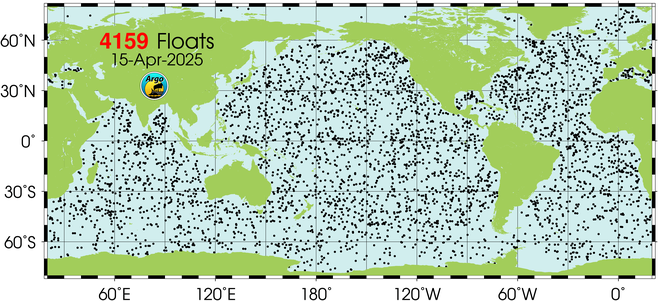
These projects are not feeding data to Argo, yet.
Depth-profiling floats¶
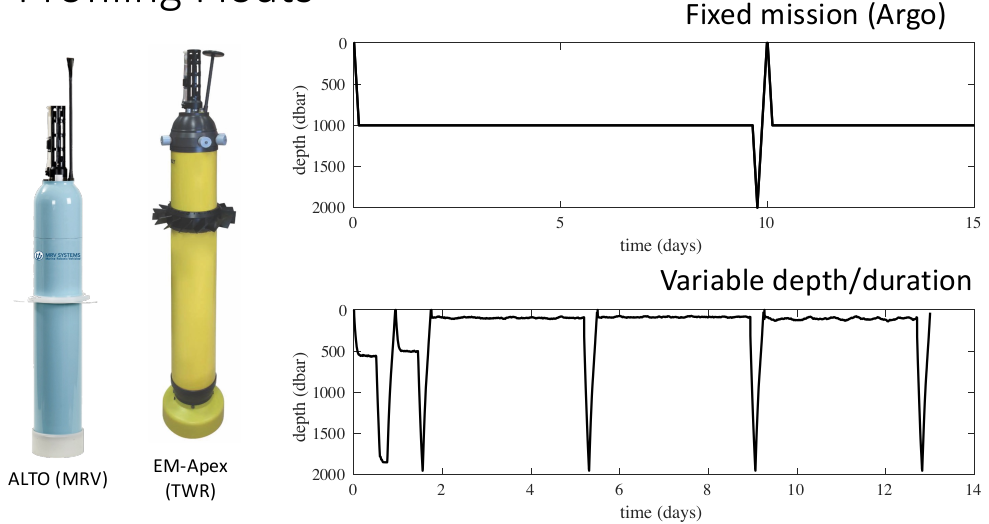
1 dbar (decibar, pressure) is approx. 1 meter. EM-APEX floats also measure current velocity.
Components of a dive¶
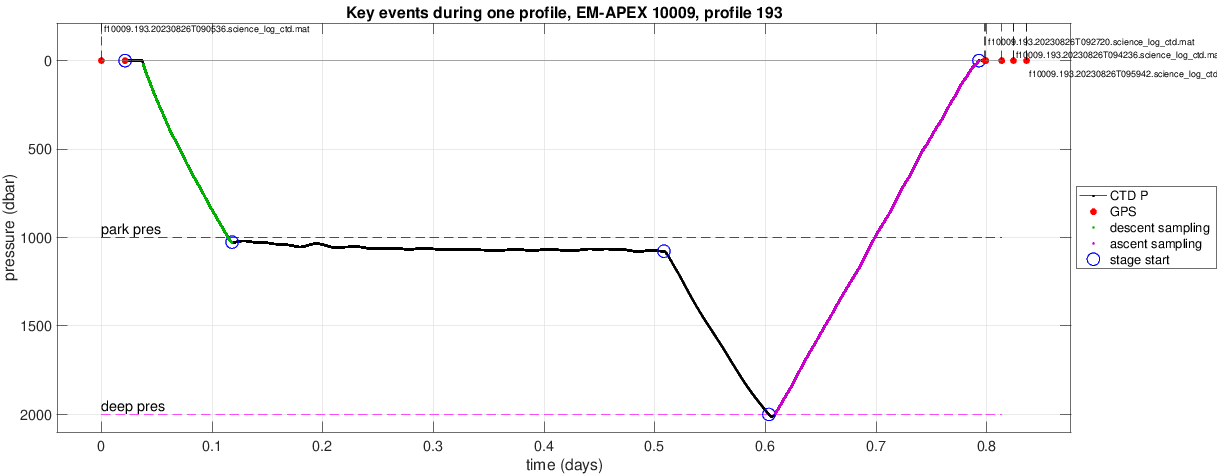
Two projects: SQUID and ALFAC¶
- SQUID: Sampling QUantitative Internal-wave Distributions
- ALFAC: Array of Lagrangian Floats for Areal Coverage
Will try to share the code for both apps on GitHub in the future. But it'll take some work
Projects: SQUID¶
- https://www.apl.uw.edu/project/project.php?id=squid. Led by James Girton, APL
- Its goal is "to improve the broad-scale characterization of internal wave climates through global deployments of autonomous profiling floats measuring shear, strain, and turbulent mixing". And to develop data standards and mechanisms to make data from EM-APEX floats more widely accessible and shareable.
- Deployments around the world
- HoloViz/Panel app: https://squid-test1.azurewebsites.net
Projects: ALFAC¶
- No public website. Led by Zoltan Szuts, APL
- Developing a "shoreside autonomy software, 'FlowPilot', that selects dive parameters (park depth & duration) to align with ocean currents favorable to the chosen sampling mission. FlowPilot uses in-situ float data and external data sources to predict float drift paths using multiple prediction methods, evaluates the prediction uncertainties, and makes a recommendation for the next dive in real-time."
- Deployment of clusters of floats within specific areas, for experiments. So far, in the Western Pacific and Gulf Stream.
- HoloViz/Panel app is for internal use only at this time
HoloViz ecosystem of packages, https://holoviz.org¶

- "a set of open-source Python packages to streamline the entire process of working with small and large datasets [for visualization and exploration] in a web browser"
- Run from scripts/modules or Jupyter notebook
- Support different plotting backends (matplotlib, plotly, etc), but
bokehis more "native" - Apps usually require server deployment and Python environment, but light-weight apps may be client-side
- Great set of working tutorials and examples, for individual packages and integrated scenarios. https://holoviz.org/tutorial/
- I will focus on:
Panel,HoloViews,GeoViews,hvPlot,param
Explore HoloViews, GeoViews and hvPlot¶
With a built-in Panel app (hvplot.explorer) on the side
from pathlib import Path
import geopandas as gpd
import pandas as pd
import hvplot.pandas # noqa
import warnings
warnings.simplefilter("ignore", category=UserWarning)
data_dpth = Path("./data")
trajectories_gdf = gpd.read_parquet(data_dpth / "gps_deployments_lines_allexperiments.geoparquet")
trajectories_start_gdf = trajectories_gdf.set_geometry('point_start_geom').drop(columns='geometry')
# Default GeoDataFrame plotting with matplotlib: trajectories_start_gdf.plot()
trajectories_start_gdf.hvplot()
# Customize a bit
trajectories_start_gdf.hvplot(
geo=True,
by='experiment',
hover_cols=['deployment', 'datetime_min'],
tiles='EsriNatGeo',
tools=['undo', 'hover'],
)
# Out-of-the-box hvplot explorer
pd.DataFrame(trajectories_start_gdf).hvplot.explorer()
# Fall back to Geo/HoloViews. See "overlay" (*) and "layout" (+) operators
import geoviews as gv, holoviews as hv
hv.extension('bokeh')
basemaptiles = gv.tile_sources.EsriOceanBase
trajectories_start = gv.Points(trajectories_start_gdf)
trajectories_start + trajectories_gdf.hvplot(geo=True)
# Now fancier, with tiles and holoviews "options"
# ( (basemaptiles * trajectories_start.opts(tools=['hover'])).opts(xlabel='lat', ylabel='lon', title="with holoviews")
# + trajectories_gdf.hvplot(geo=True, tiles='OSM', title='with hvplot')
# )
import hvplot.xarray
import xarray as xr
xr_ds = xr.tutorial.open_dataset('air_temperature').load()
xr_ds
# -- Alternatively, can play with this Zarr dataset accessed from the cloud
# From https://pangeo-forge.org/dashboard/feedstock/78
# zarr_store = 'https://ncsa.osn.xsede.org/Pangeo/pangeo-forge/pangeo-forge/AGDC-feedstock/AGCD.zarr'
# xr_ds = xr.open_dataset(zarr_store, engine='zarr', chunks={})
# Lazy loading (metadata and coordinate values only)
# Data variables loaded as lazy, chunked "Dask" arrays
# print(f"Total size (not downloaded size!): {xr_ds.nbytes/1e9:.1f} GB")
# xr_ds
<xarray.Dataset> Size: 31MB
Dimensions: (lat: 25, time: 2920, lon: 53)
Coordinates:
* lat (lat) float32 100B 75.0 72.5 70.0 67.5 65.0 ... 22.5 20.0 17.5 15.0
* lon (lon) float32 212B 200.0 202.5 205.0 207.5 ... 325.0 327.5 330.0
* time (time) datetime64[ns] 23kB 2013-01-01 ... 2014-12-31T18:00:00
Data variables:
air (time, lat, lon) float64 31MB 241.2 242.5 243.5 ... 296.2 295.7
Attributes:
Conventions: COARDS
title: 4x daily NMC reanalysis (1948)
description: Data is from NMC initialized reanalysis\n(4x/day). These a...
platform: Model
references: http://www.esrl.noaa.gov/psd/data/gridded/data.ncep.reanaly...- lat: 25
- time: 2920
- lon: 53
- lat(lat)float3275.0 72.5 70.0 ... 20.0 17.5 15.0
- standard_name :
- latitude
- long_name :
- Latitude
- units :
- degrees_north
- axis :
- Y
array([75. , 72.5, 70. , 67.5, 65. , 62.5, 60. , 57.5, 55. , 52.5, 50. , 47.5, 45. , 42.5, 40. , 37.5, 35. , 32.5, 30. , 27.5, 25. , 22.5, 20. , 17.5, 15. ], dtype=float32) - lon(lon)float32200.0 202.5 205.0 ... 327.5 330.0
- standard_name :
- longitude
- long_name :
- Longitude
- units :
- degrees_east
- axis :
- X
array([200. , 202.5, 205. , 207.5, 210. , 212.5, 215. , 217.5, 220. , 222.5, 225. , 227.5, 230. , 232.5, 235. , 237.5, 240. , 242.5, 245. , 247.5, 250. , 252.5, 255. , 257.5, 260. , 262.5, 265. , 267.5, 270. , 272.5, 275. , 277.5, 280. , 282.5, 285. , 287.5, 290. , 292.5, 295. , 297.5, 300. , 302.5, 305. , 307.5, 310. , 312.5, 315. , 317.5, 320. , 322.5, 325. , 327.5, 330. ], dtype=float32) - time(time)datetime64[ns]2013-01-01 ... 2014-12-31T18:00:00
- standard_name :
- time
- long_name :
- Time
array(['2013-01-01T00:00:00.000000000', '2013-01-01T06:00:00.000000000', '2013-01-01T12:00:00.000000000', ..., '2014-12-31T06:00:00.000000000', '2014-12-31T12:00:00.000000000', '2014-12-31T18:00:00.000000000'], shape=(2920,), dtype='datetime64[ns]')
- air(time, lat, lon)float64241.2 242.5 243.5 ... 296.2 295.7
- long_name :
- 4xDaily Air temperature at sigma level 995
- units :
- degK
- precision :
- 2
- GRIB_id :
- 11
- GRIB_name :
- TMP
- var_desc :
- Air temperature
- dataset :
- NMC Reanalysis
- level_desc :
- Surface
- statistic :
- Individual Obs
- parent_stat :
- Other
- actual_range :
- [185.16 322.1 ]
array([[[241.2 , 242.5 , 243.5 , ..., 232.8 , 235.5 , 238.6 ], [243.8 , 244.5 , 244.7 , ..., 232.8 , 235.3 , 239.3 ], [250. , 249.8 , 248.89, ..., 233.2 , 236.39, 241.7 ], ..., [296.6 , 296.2 , 296.4 , ..., 295.4 , 295.1 , 294.7 ], [295.9 , 296.2 , 296.79, ..., 295.9 , 295.9 , 295.2 ], [296.29, 296.79, 297.1 , ..., 296.9 , 296.79, 296.6 ]], [[242.1 , 242.7 , 243.1 , ..., 232. , 233.6 , 235.8 ], [243.6 , 244.1 , 244.2 , ..., 231. , 232.5 , 235.7 ], [253.2 , 252.89, 252.1 , ..., 230.8 , 233.39, 238.5 ], ..., [296.4 , 295.9 , 296.2 , ..., 295.4 , 295.1 , 294.79], [296.2 , 296.7 , 296.79, ..., 295.6 , 295.5 , 295.1 ], [296.29, 297.2 , 297.4 , ..., 296.4 , 296.4 , 296.6 ]], [[242.3 , 242.2 , 242.3 , ..., 234.3 , 236.1 , 238.7 ], [244.6 , 244.39, 244. , ..., 230.3 , 232. , 235.7 ], [256.2 , 255.5 , 254.2 , ..., 231.2 , 233.2 , 238.2 ], ..., ... [294.79, 295.29, 297.49, ..., 295.49, 295.39, 294.69], [296.79, 297.89, 298.29, ..., 295.49, 295.49, 294.79], [298.19, 299.19, 298.79, ..., 296.09, 295.79, 295.79]], [[245.79, 244.79, 243.49, ..., 243.29, 243.99, 244.79], [249.89, 249.29, 248.49, ..., 241.29, 242.49, 244.29], [262.39, 261.79, 261.29, ..., 240.49, 243.09, 246.89], ..., [293.69, 293.89, 295.39, ..., 295.09, 294.69, 294.29], [296.29, 297.19, 297.59, ..., 295.29, 295.09, 294.39], [297.79, 298.39, 298.49, ..., 295.69, 295.49, 295.19]], [[245.09, 244.29, 243.29, ..., 241.69, 241.49, 241.79], [249.89, 249.29, 248.39, ..., 239.59, 240.29, 241.69], [262.99, 262.19, 261.39, ..., 239.89, 242.59, 246.29], ..., [293.79, 293.69, 295.09, ..., 295.29, 295.09, 294.69], [296.09, 296.89, 297.19, ..., 295.69, 295.69, 295.19], [297.69, 298.09, 298.09, ..., 296.49, 296.19, 295.69]]], shape=(2920, 25, 53))
- latPandasIndex
PandasIndex(Index([75.0, 72.5, 70.0, 67.5, 65.0, 62.5, 60.0, 57.5, 55.0, 52.5, 50.0, 47.5, 45.0, 42.5, 40.0, 37.5, 35.0, 32.5, 30.0, 27.5, 25.0, 22.5, 20.0, 17.5, 15.0], dtype='float32', name='lat')) - lonPandasIndex
PandasIndex(Index([200.0, 202.5, 205.0, 207.5, 210.0, 212.5, 215.0, 217.5, 220.0, 222.5, 225.0, 227.5, 230.0, 232.5, 235.0, 237.5, 240.0, 242.5, 245.0, 247.5, 250.0, 252.5, 255.0, 257.5, 260.0, 262.5, 265.0, 267.5, 270.0, 272.5, 275.0, 277.5, 280.0, 282.5, 285.0, 287.5, 290.0, 292.5, 295.0, 297.5, 300.0, 302.5, 305.0, 307.5, 310.0, 312.5, 315.0, 317.5, 320.0, 322.5, 325.0, 327.5, 330.0], dtype='float32', name='lon')) - timePandasIndex
PandasIndex(DatetimeIndex(['2013-01-01 00:00:00', '2013-01-01 06:00:00', '2013-01-01 12:00:00', '2013-01-01 18:00:00', '2013-01-02 00:00:00', '2013-01-02 06:00:00', '2013-01-02 12:00:00', '2013-01-02 18:00:00', '2013-01-03 00:00:00', '2013-01-03 06:00:00', ... '2014-12-29 12:00:00', '2014-12-29 18:00:00', '2014-12-30 00:00:00', '2014-12-30 06:00:00', '2014-12-30 12:00:00', '2014-12-30 18:00:00', '2014-12-31 00:00:00', '2014-12-31 06:00:00', '2014-12-31 12:00:00', '2014-12-31 18:00:00'], dtype='datetime64[ns]', name='time', length=2920, freq=None))
- Conventions :
- COARDS
- title :
- 4x daily NMC reanalysis (1948)
- description :
- Data is from NMC initialized reanalysis (4x/day). These are the 0.9950 sigma level values.
- platform :
- Model
- references :
- http://www.esrl.noaa.gov/psd/data/gridded/data.ncep.reanalysis.html
xr_ds['air'].sel(time='2013-06-01 12:00').hvplot()
# Let hvplot create a slider widget to interactively flip through time
xr_ds['air'].hvplot(groupby='time')
Quick Panel demo¶
Define a couple of Panel widgets and link them to a dataset via .interactive() method
Demo taken from https://hvplot.holoviz.org
import panel as pn
w_quantile = pn.widgets.FloatSlider(name='quantile', start=0, end=1)
w_time = pn.widgets.IntSlider(name='time', start=0, end=10)
( xr_ds['air'].interactive(loc='left')
.isel(time=w_time)
.quantile(q=w_quantile, dim='lon')
.hvplot(ylabel='Air Temperature [K]', width=500) )
Source data structure and formats¶
SQUID: source netCDF file and pre-processed GeoParquet files¶
- (Geo)Parquet: open "columnar" data store with chunking and compression, plays well in cloud object storage
- Pre-processing done with xarray, GeoPandas.
GeoParquetfile generated from source netCDF file, to extract point and lat-lon line geometries and aggregated attributes, for quick & convenient access in the SQUID App.- That's the
gps_deployments_lines_allexperiments.geoparquetfile used earlier in thehvPlotdemo. Includes both line and point geometry columns.
SQUID: binned netCDF file, with several float "trajectories"¶
- A data product heavily post-processed through scripts that could be fully automated.
- Not a regular grid structure; a "discrete sampling geometries" feature type, per netCDF data model.
- Open the netCDF file with xarray, examine its structure.
zgrid_ds = xr.open_dataset(data_dpth / "SQUID_NCEI.nc", decode_times=False)
zgrid_ds
<xarray.Dataset> Size: 600MB
Dimensions: (trajectory: 20, obs: 234, z: 2001, trid_len: 6)
Coordinates:
* trajectory (trajectory) int32 80B 1 2 3 4 5 6 7 8 ... 14 15 16 17 18 19 20
time (obs, trajectory) float64 37kB ...
lat (obs, trajectory) float64 37kB ...
lon (obs, trajectory) float64 37kB ...
Dimensions without coordinates: obs, z, trid_len
Data variables: (12/17)
depth (z) float64 16kB ...
T (z, obs, trajectory) float64 75MB ...
S (z, obs, trajectory) float64 75MB ...
P (z, obs, trajectory) float64 75MB ...
U (z, obs, trajectory) float64 75MB ...
V (z, obs, trajectory) float64 75MB ...
... ...
flid (trajectory) int32 80B ...
trid (trid_len, trajectory) |S1 120B ...
pid (obs, trajectory) float64 37kB ...
hpid (obs, trajectory) float64 37kB ...
depl (trajectory) int32 80B ...
EM-APEX float64 8B ...
Attributes: (12/26)
ncei_template_version: NCEI_NetCDF_TrajectoryProfile_Incomplete_Temp...
featureType: trajectoryProfile
title: T, S, U, V and derived quantities measured by...
summary: T, S, potential density, N^2, U, V, u_z, and ...
Conventions: CF-1.6, ACDD-1.3
acknowledgments: NOPP Global Internal Wave Project. Funding fr...
... ...
geospatial_lat_units: degree_north
geospatial_lon_units: degree_east
geospatial_vertical_units: meters
platform: EM-APEX
references:
comment: Deployed from multiple cruises of opportunity...- trajectory: 20
- obs: 234
- z: 2001
- trid_len: 6
- trajectory(trajectory)int321 2 3 4 5 6 7 ... 15 16 17 18 19 20
- long_name :
- Unique identifier for each feature instance
- cf_role :
- trajectory_id
- comment :
- ID number of Float-Deployment pair
array([ 1, 2, 3, 4, 5, 6, 7, 8, 9, 10, 11, 12, 13, 14, 15, 16, 17, 18, 19, 20], dtype=int32) - time(obs, trajectory)float64...
- long_name :
- Time, UTC
- standard_name :
- time
- units :
- seconds since 1970-01-01 00:00:00 0:00
- calendar :
- Julian
- axis :
- T
[4680 values with dtype=float64]
- lat(obs, trajectory)float64...
- long_name :
- mean latitude of EM-APEX profiles
- standard_name :
- latitude
- units :
- degree_north
- axis :
- Y
- valid_min :
- -45.5395
- valid_max :
- 37.1694
- comment :
- Mean latitude during each float dive
- Coordinates :
- time lat lon
[4680 values with dtype=float64]
- lon(obs, trajectory)float64...
- long_name :
- mean longitude of EM-APEX profiles
- standard_name :
- longitude
- units :
- degree_east
- axis :
- X
- valid_min :
- -125.105
- valid_max :
- 93.4306
- comment :
- Mean longitude during each float dive
- Coordinates :
- time lat lon
[4680 values with dtype=float64]
- depth(z)float64...
- long_name :
- depths of gridded EM-APEX profiles
- standard_name :
- depth
- units :
- meters [m]
- axis :
- Z
- positive :
- down
- valid_min :
- 0
- valid_max :
- 2000
- comment :
- Profile depths interpolated to common grid
[2001 values with dtype=float64]
- T(z, obs, trajectory)float64...
- long_name :
- gridded EM-APEX temperature
- standard_name :
- sea_water_temperature
- units :
- Kelvin
- platform_variable :
- EM_APEX
- instrument :
- thermistor
[9364680 values with dtype=float64]
- S(z, obs, trajectory)float64...
- long_name :
- gridded EM-APEX salinity
- standard_name :
- sea_water_salinity
- units :
- 1e-3
- platform_variable :
- EM_APEX
- comment :
- Units are standard psu. The units refered to in Units attribute refer to the CF Convention for standard name and units.
[9364680 values with dtype=float64]
- P(z, obs, trajectory)float64...
- long_name :
- gridded EM-APEX pressure derived from depth and latitude
- standard_name :
- sea_water_pressure
- units :
- decibar
- platform_variable :
- EM_APEX
[9364680 values with dtype=float64]
- U(z, obs, trajectory)float64...
- long_name :
- gridded EM-APEX east velocity component
- standard_name :
- eastward_sea_water_velocity
- units :
- meter per second
- platform_variable :
- EM_APEX
- instrument :
- EM-APEX
[9364680 values with dtype=float64]
- V(z, obs, trajectory)float64...
- long_name :
- gridded EM-APEX north velocity component
- standard_name :
- northward_sea_water_velocity
- units :
- meter per second
- platform_variable :
- EM_APEX
- instrument :
- EM-APEX
[9364680 values with dtype=float64]
- chi1(z, obs, trajectory)float64...
- long_name :
- temperature_variance_dissipation
- units :
- degree Celsius square per second
- platform_variable :
- EM_APEX
- comment :
- Rate of dissipation of temperature variance measured by Probe 1
[9364680 values with dtype=float64]
- chi2(z, obs, trajectory)float64...
- long_name :
- temperature_variance_dissipation
- units :
- degree Celsius square per second
- platform_variable :
- EM_APEX
- comment :
- Rate of dissipation of temperature variance measured by Probe 2
[9364680 values with dtype=float64]
- ptime(z, obs, trajectory)float64...
- long_name :
- time_along_profile
- units :
- seconds since 1970-01-01 00:00:00 0:00
- calendar :
- Julian
- platform_variable :
- EM_APEX
[9364680 values with dtype=float64]
- U0(obs, trajectory)float64...
- long_name :
- Drift eastward velocity of a float while at surface
- standard_name :
- surface eastward velocity
- units :
- meter per second
- Coordinates :
- time lat lon
[4680 values with dtype=float64]
- V0(obs, trajectory)float64...
- long_name :
- Drift northward velocity of a float while at surface
- standard_name :
- surface northward velocity
- units :
- meter per second
- Coordinates :
- time lat lon
[4680 values with dtype=float64]
- flid(trajectory)int32...
- long_name :
- EM-APEX float id number
- standard_name :
- Float id number
[20 values with dtype=int32]
- trid(trid_len, trajectory)|S1...
- long_name :
- Trajectory id
- comment :
- A 2-dimensional character array representing a unique trajectory id string per float deployment. The rendering of this trajectory id is dependent on the software used to read the netcdfs. If the trajectory id does not look like a composition of a float number and characters (e.g. 'f9436', '7805s2'), try to compose the trajectory id string by concatenating the characters over the trid_len dimension
[120 values with dtype=|S1]
- pid(obs, trajectory)float64...
- long_name :
- Profile id number
- comment :
- Profile number, where a profile consist of a full down + up cycle
[4680 values with dtype=float64]
- hpid(obs, trajectory)float64...
- long_name :
- Half-profile id number
- comment :
- A Half profile consist of either a down or up profile. Odd number are down-profiles, even numbers are up-profiles
[4680 values with dtype=float64]
- depl(trajectory)int32...
- long_name :
- Deployment number of a float
- standard_name :
- deployment
- comment :
- Deployment number within an experiment. An experiment can have a single deployment or multiple deployments where all or part of the float array are deployed.
[20 values with dtype=int32]
- EM-APEX()float64...
- long_name :
- EM-APEX
- wmo_code :
[1 values with dtype=float64]
- trajectoryPandasIndex
PandasIndex(Index([1, 2, 3, 4, 5, 6, 7, 8, 9, 10, 11, 12, 13, 14, 15, 16, 17, 18, 19, 20], dtype='int32', name='trajectory'))
- ncei_template_version :
- NCEI_NetCDF_TrajectoryProfile_Incomplete_Template_v2.0
- featureType :
- trajectoryProfile
- title :
- T, S, U, V and derived quantities measured by EM-APEX during SQUIDexperiment
- summary :
- T, S, potential density, N^2, U, V, u_z, and v_z measured by EM-APEX float and interpolated onto a common depth grid
- Conventions :
- CF-1.6, ACDD-1.3
- acknowledgments :
- NOPP Global Internal Wave Project. Funding from the National Science Foundation (OCE-2232796)
- date_created :
- 23-Jul-2024 09:14:39
- creator_name :
- James Girton, Aurelie Moulin
- creator_email :
- girton@uw.edu, amoulin@uw.edu
- Institution :
- Applied Physics Laboratory - University of Washington
- geospatial_lat_min :
- -59.1682 (>0, N; <0, S)
- geospatial_lat_max :
- 40.8682 (>0, N; <0, S)
- geospatial_lon_min :
- -159.1725 (>0, E; <0, W)
- geospatial_lon_max :
- 155.869 (>0, E; <0, W)
- vertical_min :
- 0.0
- vertical_max :
- 2000.0
- vertical_positive :
- up
- time_coverage_start :
- 18-Feb-2023 21:11:05
- time_coverage_end :
- 09-Jul-2024 00:16:00
- sea_name :
- Multiple
- geospatial_lat_units :
- degree_north
- geospatial_lon_units :
- degree_east
- geospatial_vertical_units :
- meters
- platform :
- EM-APEX
- references :
- comment :
- Deployed from multiple cruises of opportunity worlwide for the Sampling Quantitative Internal Waves Dissipation project (SQUID)starting in Feb 2023. PI: James Girton (girton@uw.edu)
ALFAC: FlowPilot Database (PostgreSQL)¶
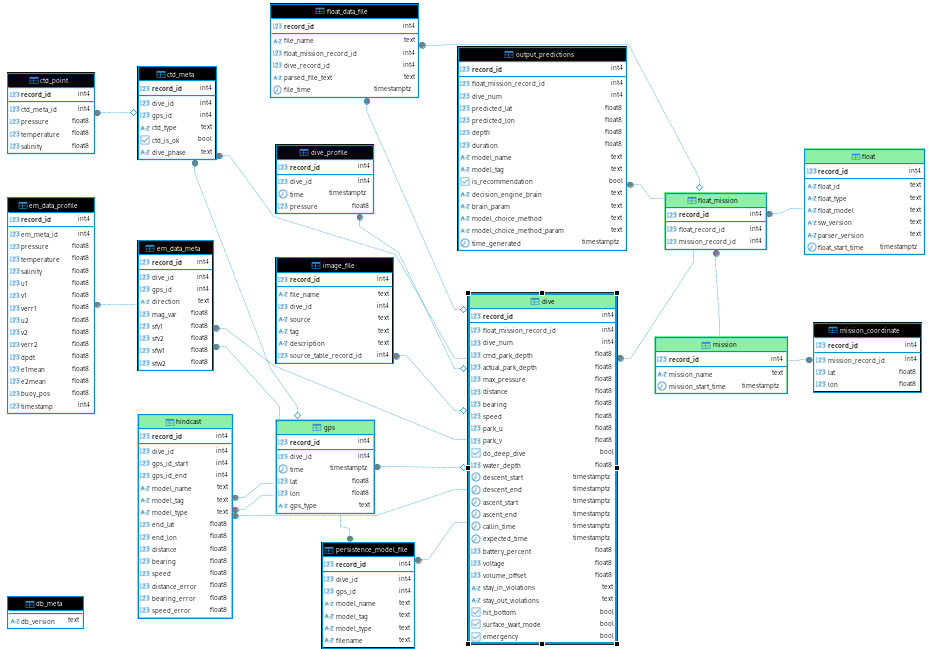
Tables used by the FlowPilot Visualization App¶

Sample SQL for pre-processing, for viz app¶
For dive data. SQL code trimmed a bit. Pulled in from DB via pandas.read_sql_query(). This is followed by a lot of additional processing: further data cleaning, timestamp formatting, creating point and line GeoDataFrames, creating dynamic HoloViews elements, etc.
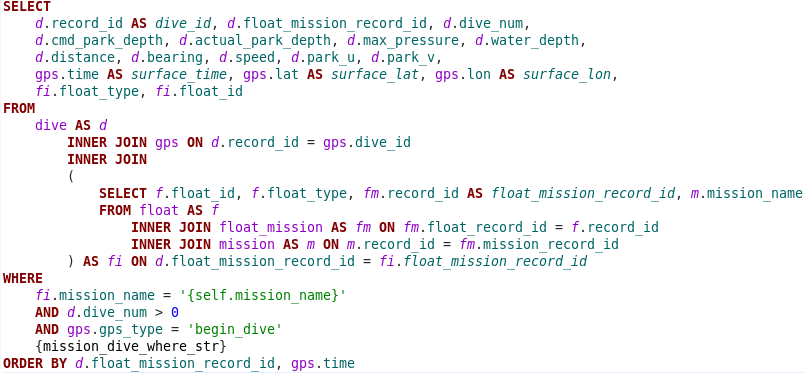
The apps¶
Or at least screenshots
SQUID¶

ALFAC / FlowPilot¶
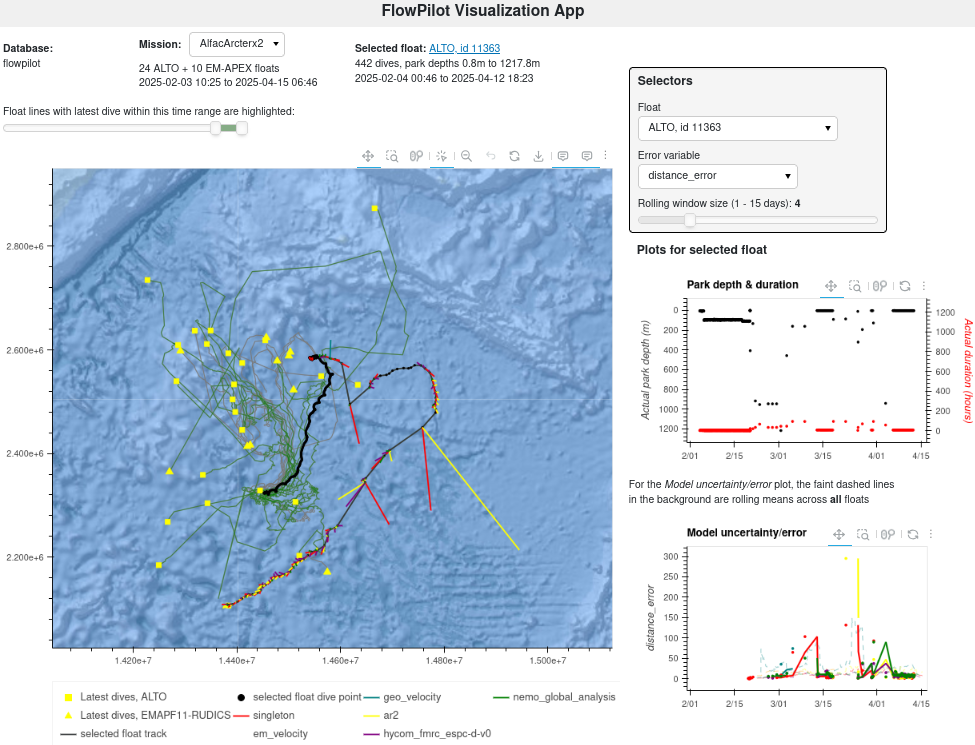
HoloViz code snippets from my apps¶
Select a "trajectory" based on change to a text widget, trajectory_sel_text. The .apply() method in action, passing a param object.
def select_by_trid(hvds, trajectory_id):
return hvds.select(trajectory_id=trajectory_id)
selected_trajectory_layer = (
gps_deployments_hvPath.relabel("Selected trajectory").apply(
select_by_trid,
trajectory_id=trajectory_sel_text.param.value,
).opts(color='yellow', line_width=3)
)
Update the trajectory_sel_text Panel text widget based on a selection ("tap") action on gps_deployments_hvPath line element.
traj_stream = Selection1D(source=gps_deployments_hvPath, index=[0])
@pn.depends(s=traj_stream.param.index, watch=True)
def _update_traj_select(s):
select_index = s[0] if s else 0
trajectory_sel_text.value = traj_lines_trajid_vs_idx[select_index]
Use CSS and styling properties to heavily customiz appearance and rendering of a Panel element.
MARKDOWN_CSS = """
p { margin: 1px; padding-top: 0px; padding-bottom: 0px;
border: 0.5px solid #cccccc; font-size: 11pt; }
"""
sel_trajectory_pn_md = pn.pane.Markdown(
sel_traj_display_str(trajectory_id_initial),
styles={'padding-top': '0px', 'padding-bottom': '0px'},
stylesheets=[MARKDOWN_CSS]
)
Arrange app elements using Panel Row and Col elements
header_bar_mission_col = pn.Column(
pn.Row(
fpv_md.header_bar_mission,
fpv_widgets.mission_select),
pn.Row(
fpv_md.header_bar_mission_info,
margin=0),
margin=0, width=260,
)
Use a Panel web framework template.
app_template = pn.template.FastListTemplate(
title=title_str, sidebar_width=400,
sidebar=[pn.pane.Markdown(description_md), pn.pane.Markdown("### SQUID")],
main=[pn.Row(traj_sel_text, sel_traj_pn_md,
align='center', margin=0, styles={'padding-top': '0px'}),
plots_accordion],
theme_toggle=False, background='lightgray'
)
Running the app¶
- Within the app code, use
my_panel_app_object.servable()(ormy_panel_app_object.servable().show()for testing). - From command line:
panel serve --autoreload --global-loading-spinner --port 5100 --allow-websocket-origin='*' --log-file mylogfile.log basepath/myappnotebook.ipynb- Bare bones:
panel serve basepath/myappnotebook.ipynb
- Bare bones:
App deployment¶
- SQUID
- MS
Azure(using Ubuntu Linux). https://squid-test1.azurewebsites.net - Maintained and developed in a local git clone
- Updates deployed via Azure Git push. Python environment maitained via
pip(orDockercontainer, but I wanted to keep things simple) - Project page https://www.apl.uw.edu/project/project.php?id=squid
- MS
- ALFAC
- Everything is in APL network only, behind VPN
- Deployment to an Ubuntu server, with Apache
- Maintained and developed via project GitLab.
- Updates deployed via Git pull from GitLab repo
- TROCAS
- CO2 at the mouth of the Amazon River, sampled continuously by boat
- On GitHub, https://github.com/amazon-riverbgc/trocas-herokuapp1. But the code is getting long in the tooth!
- Deployment to
Herokuvia Heroku CLI, asDockercontainer - See https://amazon-riverbgc.github.io/TROCAS/docs/databrowser.html